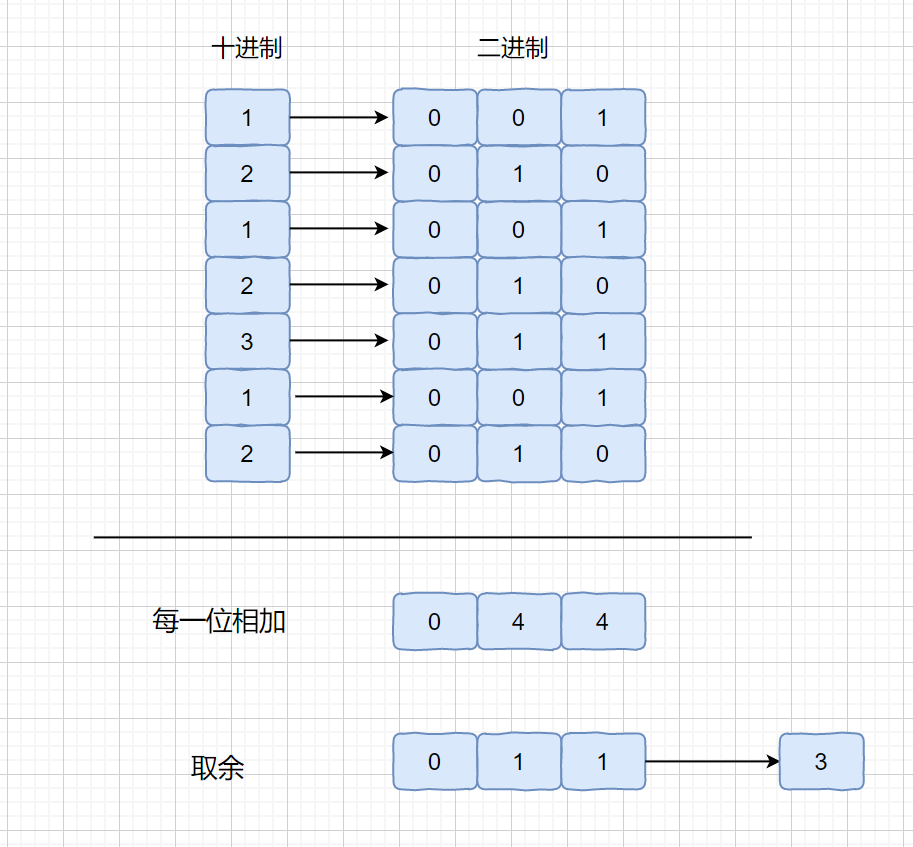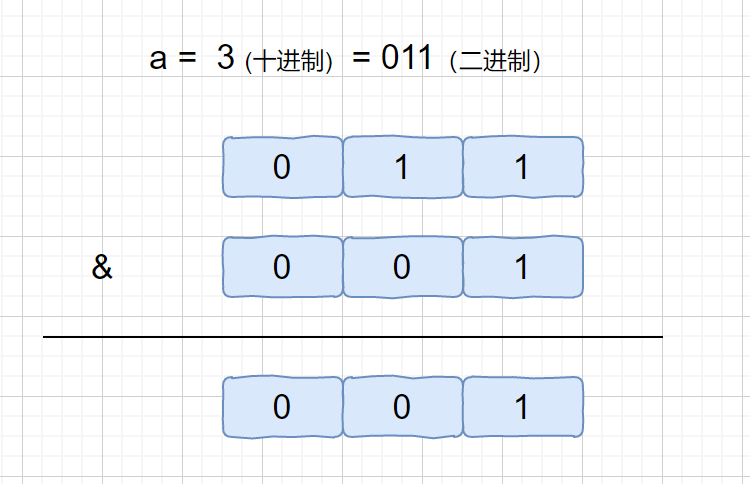290 lines
9.2 KiB
Markdown
290 lines
9.2 KiB
Markdown
> 如果阅读时,发现错误,或者动画不可以显示的问题可以添加我微信好友 **[tan45du_one](https://raw.githubusercontent.com/tan45du/tan45du.github.io/master/个人微信.15egrcgqd94w.jpg)** ,备注 github + 题目 + 问题 向我反馈
|
||
>
|
||
> 感谢支持,该仓库会一直维护,希望对各位有一丢丢帮助。
|
||
>
|
||
> 另外希望手机阅读的同学可以来我的 <u>[**公众号:袁厨的算法小屋**](https://raw.githubusercontent.com/tan45du/test/master/微信图片_20210320152235.2pthdebvh1c0.png)</u> 两个平台同步,想要和题友一起刷题,互相监督的同学,可以在我的小屋点击<u>[**刷题小队**](https://raw.githubusercontent.com/tan45du/test/master/微信图片_20210320152235.2pthdebvh1c0.png)</u>进入。
|
||
|
||
#### [137. 只出现一次的数字 II](https://leetcode-cn.com/problems/single-number-ii/)
|
||
|
||
> 给定一个非空整数数组,除了某个元素只出现一次以外,其余每个元素均出现了三次。找出那个只出现了一次的元素。
|
||
|
||
示例 1:
|
||
|
||
> 输入: [2,2,3,2]
|
||
> 输出: 3
|
||
|
||
示例 2:
|
||
|
||
> 输入: [0,1,0,1,0,1,99]
|
||
> 输出: 99
|
||
|
||
题目很容易理解,刚才的题目是其他元素出现两次,目标元素出现一次,该题是其他元素出现三次,目标元素出现一次,所以我们完全可以借助上题的一些做法解决该题。
|
||
|
||
### 求和法
|
||
|
||
#### 解析
|
||
|
||
我们在上题中介绍了求和法的解题步骤,现在该题中其他元素都出现三次,我们的目标元素出现一次,所以我们利用求和法也是完全 OK 的。下面我们来看具体步骤吧。
|
||
|
||
1.通过遍历数组获取所有元素的和以及 HashSet 内元素的和。
|
||
|
||
2.(SumSet \* 3 - SumNum)/ 2 即可,除以 2 是因为我们减去之后得到的是 2 倍的目标元素。
|
||
|
||
注:这个题目中需要注意溢出的情况 。
|
||
|
||
#### 题目代码
|
||
|
||
Java Code:
|
||
|
||
```java
|
||
class Solution {
|
||
public int singleNumber(int[] nums) {
|
||
HashSet<Integer> set = new HashSet<>();
|
||
long setsum = 0;
|
||
long numsum = 0;
|
||
for (int x : nums) {
|
||
//所有元素的和
|
||
numsum += x;
|
||
if (!set.contains(x)) {
|
||
//HashSet元素和
|
||
setsum += x;
|
||
}
|
||
set.add(x);
|
||
}
|
||
//返回只出现一次的数
|
||
return (int)((3 * setsum - numsum) / 2);
|
||
}
|
||
}
|
||
```
|
||
|
||
C++ Code:
|
||
|
||
```cpp
|
||
class Solution {
|
||
public:
|
||
int singleNumber(vector<int>& nums) {
|
||
unordered_set<int> set;
|
||
long setsum = 0;
|
||
long numsum = 0;
|
||
for (int x : nums) {
|
||
//所有元素的和
|
||
numsum += x;
|
||
if (set.find(x) == set.end()) {
|
||
//HashSet内元素的和
|
||
setsum += x;
|
||
}
|
||
set.insert(x);
|
||
}
|
||
//返回值
|
||
return (3 * setsum - numsum) / 2;
|
||
}
|
||
};
|
||
```
|
||
|
||
JS Code:
|
||
|
||
```javascript
|
||
var singleNumber = function (nums) {
|
||
let set = new Set();
|
||
let setsum = 0;
|
||
let numsum = 0;
|
||
for (let x of nums) {
|
||
//所有元素的和
|
||
numsum += x;
|
||
if (!set.has(x)) {
|
||
setsum += x;
|
||
}
|
||
//HashSet内元素的和
|
||
set.add(x);
|
||
}
|
||
//返回值
|
||
return (3 * setsum - numsum) / 2;
|
||
};
|
||
```
|
||
|
||
Python Code:
|
||
|
||
```python
|
||
class Solution:
|
||
def singleNumber(self, nums: List[int]) -> int:
|
||
return (3 * sum(set(nums)) - sum(nums)) // 2
|
||
```
|
||
|
||
这个题目用 HashMap 和排序查找肯定也是可以的,大家可以自己写一下,另外我们在第一题中有个利用异或求解的方法,但是这个题目是出现三次,我们则不能利用直接异或来求解,那还有其他方法吗?
|
||
|
||
### 位运算
|
||
|
||
#### 解析
|
||
|
||
这个方法主要做法是将我们的数的二进制位每一位相加,然后对其每一位的和与 3 取余 ,我们看下面的例子。
|
||
|
||

|
||
|
||
那么我们为什么要这样做呢?大家想一下,如果其他数都出现 3 次,只有目标数出现 1 次,那么每一位的 1 的个数无非有这两种情况,为 3 的倍数(全为出现三次的数)或 3 的倍数 +1(包含出现一次的数)。这个 3 的倍数 +1 的情况也就是我们的目标数的那一位。
|
||
|
||
#### 题目代码
|
||
|
||
Java Code:
|
||
|
||
```java
|
||
class Solution {
|
||
public int singleNumber(int[] nums) {
|
||
int res = 0;
|
||
for(int i = 0; i < 32; i++){
|
||
int count = 0;
|
||
for (int num: nums) {
|
||
//检查第 i 位是否为 1
|
||
if ((num >> i & 1) == 1) {
|
||
count++;
|
||
}
|
||
}
|
||
if (count % 3 != 0) {
|
||
// 将第 i 位设为 1
|
||
res = res | 1 << i;
|
||
}
|
||
}
|
||
return res;
|
||
}
|
||
}
|
||
```
|
||
|
||
C++ Code:
|
||
|
||
```cpp
|
||
class Solution {
|
||
public:
|
||
int singleNumber(vector<int>& nums) {
|
||
int res = 0;
|
||
for(int i = 0; i < 32; i++){
|
||
int count = 0;
|
||
for (int num: nums) {
|
||
//检查第 i 位是否为 1
|
||
if ((num >> i & 1) == 1) {
|
||
count++;
|
||
}
|
||
}
|
||
if (count % 3 != 0) {
|
||
// 将第 i 位设为 1
|
||
res = res | 1 << i;
|
||
}
|
||
}
|
||
return res;
|
||
}
|
||
};
|
||
```
|
||
|
||
JS Code:
|
||
|
||
```javascript
|
||
var singleNumber = function (nums) {
|
||
let res = 0;
|
||
for (let i = 0; i < 32; i++) {
|
||
let count = 0;
|
||
for (let num of nums) {
|
||
//检查第 i 位是否为 1
|
||
if (((num >> i) & 1) == 1) {
|
||
count++;
|
||
}
|
||
}
|
||
if (count % 3 != 0) {
|
||
// 将第 i 位设为 1
|
||
res = res | (1 << i);
|
||
}
|
||
}
|
||
return res;
|
||
};
|
||
```
|
||
|
||
Python Code:
|
||
|
||
```python
|
||
class Solution:
|
||
def singleNumber(self, nums: List[int]) -> int:
|
||
res = 0
|
||
for i in range(32):
|
||
count = 0
|
||
for num in nums:
|
||
# 检查第 i 位是否为 1
|
||
if (num >> i & 1) == 1:
|
||
count += 1
|
||
if count % 3 != 0:
|
||
# 将第 i 位设为 1
|
||
res = res | 1 << i
|
||
# 这里的做法稍有不同,见下方解释
|
||
if (res >> 31 & 1) == 1:
|
||
res = ~(res ^ 4294967295)
|
||
return res
|
||
```
|
||
|
||
Go Code:
|
||
|
||
```go
|
||
func singleNumber(nums []int) int {
|
||
res := 0
|
||
// Go语言中,int占32位以上
|
||
for i := 0; i < 64; i++ {
|
||
cnt := 0
|
||
for j := 0; j < len(nums); j++ {
|
||
if (nums[j] >> i & 1) == 1 {
|
||
cnt++
|
||
}
|
||
}
|
||
if cnt % 3 != 0{
|
||
res = res | 1 << i
|
||
}
|
||
}
|
||
return res
|
||
}
|
||
```
|
||
|
||
我们来解析一下我们的代码:
|
||
|
||
> **<<** 左移运算符:运算数的各二进位全部左移若干位,由 **<<** 右边的数字指定了移动的位数,高位丢弃,低位补 0。
|
||
>
|
||
> **>>** 右移运算符:**>> ** 左边的运算数的各二进位全部右移若干位,**>>** 右边的数字指定了移动的位数。
|
||
|
||
另外我们的代码中还包含了 a & 1 和 a | 1 这有什么作用呢?继续看下图。
|
||
|
||
> **&** 按位与运算符:参与运算的两个值,如果两个相应位都为 1,则该位的结果为 1,否则为 0。
|
||
|
||

|
||
|
||
因为我们 a & 1 中 1 只有最后一位为 1,其余位皆为 0 ,所以我们发现 **a & 1 的作用就是判断 a 的最后一位是否为 1** ,如果 a 的最后一位为 1 ,a & 1 = 1,否则为 0 。所以我们还可以通过这个公式来判断 a 的奇偶性。
|
||
|
||
> **|** 按位或运算符:只要对应的二个二进位有一个为 1 时,结果位就为 1。
|
||
|
||

|
||
|
||
这个公式的作用就是**将我们移位后的 res 的最后一位 0 变为 1**。这个 1 也就代表着我们只出现一次元素的某一位。
|
||
|
||
> 贡献者[@jaredliw](https://github.com/jaredliw)注:
|
||
>
|
||
> 这里我想解释一下 python 里的这两行:
|
||
>
|
||
> ```python
|
||
> if (res >> 31 & 1) == 1:
|
||
> res = ~(res ^ 4294967295)
|
||
> ```
|
||
>
|
||
> int 的的符号是由最高位(这题用的是 32 位)的值决定,1 就是负数,0 就是正数。由于 python 的 int 类型理论上是无限大的,这题里的 res 都会被认定为是正数。举个例子,32 位的 -4 是这样的:
|
||
>
|
||
> > 11111111111111111111111111111100 (最高位是 1 )= -4
|
||
>
|
||
> python 里的则是这样的:
|
||
>
|
||
> > ...000000000000 11111111111111111111111111111100 (前面跟着无限个 0,最高位是 0 )= 4294967292
|
||
>
|
||
> 怎么办呢?
|
||
>
|
||
> 我们可以先将 res 的后 32 位取反(与 4294967295 异或,4294967295 的二进制是 32 个 1),得到:
|
||
>
|
||
> > ...000000000000 00000000000000000000000000000011(最高位是 0)= 3
|
||
>
|
||
> 之后再用波浪号按位取反,得到:
|
||
>
|
||
> > ...111111111111 11111111111111111111111111111100 (前面跟着无限个 1,最高位是 1)= -4
|
||
>
|
||
> 大家可以自行验证看看:`(res >> n & 1) == 1` ,n 随便填个大于 31 的数字,之前是 false,之后就变成 true (代表第 33 位,第 34 位,……都转成 1 了)。
|
||
>
|
||
> 虽然说这种方法有一种脱裤子放屁的感觉 ,而且`res -= 2 ** 32` 也能办到,但由于涉及到 int 存储的问题(我省略了许多,大家自行度娘哈),我觉得还是有必要知道的。
|